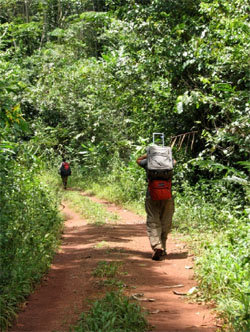Dear Geographers,
Since August, I have been consulting with the US Agency for International Development (USAID) and World Wildlife Fund (WWF). My task was to evaluate the effectiveness of integrating population and health interventions with environmental conservation efforts in priority ecological “hot spots” in Africa and Asia. In this capacity, I’ve visited Philippines, Nepal, India, Madagascar, Kenya, Cameroon, Central African Republic, and Ethiopia. Phew!
WWF Community Conservation Directory, Judy Oglethorpe accompanied me on these travels. A typical week for us would be a stay at a chain hotel in a capital city, where we would meet with national GOs and NGO partners such as the USAID missions, WWF offices, and Ministries of Health. Somnambulant from jet lag, we would then be lurched from the creature comforts of a Hilton to the wilds of some of the poorest, most remote corners of the country – these are the places, of course, where wildlife remains to conserve. Although each of the sites is in early demographic and development stages, I was surprised at the diversity that existed among them. For example, the marine conservation sites were home to fishing families who were subsisting quite satisfactorily with at least some government presence in the form of basic municipal services and health care. Meanwhile, Pygmies recently settled into communities at the forest’s edge of the Congo Basin were suffering infant mortality rates exceeding 50% – higher than several years ago when they remained foragers in the rainforest. (The Kenyan Boni people we visited near the Somali border were suffering a similar plight.)
The work was intellectually, physically, and emotionally intense. Intellectually, it was challenging to shift from research mode (how do we best measure this?) to applied mode (how can we improve services to people now?). The latter is a management problem I am unequipped by training to resolve. Nevertheless, I have broadened my horizons during these travels and am excited to pursue several research ideas borne from recent collaborations.
Although I admit that I spent most days sitting on my duff interviewing people, there were some physically challenging moments. One memorable sojourn was our attempt to use a vehicle for transportation on an old logging road through the CAR forest on the border of Congo-Brazzaville. After successfully clearing brush around several fallen trees we were halted in our tracks by the mother of all mahoganies. I was forced to leave one of my luggage bags and haul my remaining two bags and continue on foot to the river border – one frequented by arms and diamond traders who take advantage of the absence of a customs station.
Emotionally, it was difficult to experience places where astonishing natural beauty and abject human suffering coexist. When more than half of newborns die, when endemic malaria, schistosomiasis, and gastrointestinal illnesses are punctuated by occasional Ebola outbreaks, and when most of this misery can be palliated overnight at pennies per capita, our place in the world is challenged. It was this sort of metaphysical disquiet, not the pseudo-threat (although the US State Department took this quite seriously following a threat to kidnap US citizens) presented by the rag-tag Al Qaeda crew who had stumbled across the Somali border searching for food, that reminded me of my own mortality. Moving on now, I am quite pleased to report that, aside from catching a gnarly flu in Nepal, I have successfully navigated some of the planet’s most disease-rich areas with health intact. See you all in January.
(Photos courtesy of J. Oglethorpe, WWF)







